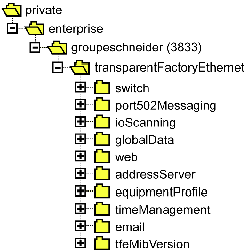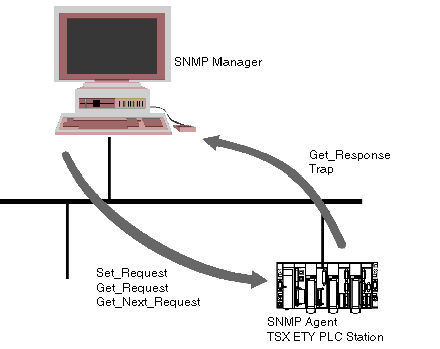The SNMP (Simple Network Management Protocol) standard defines network management solutions in terms of protocol and the exchange of supervised data.
The SNMP structure relies on the following essential elements:
-
The Manager allows entire or partial network supervision,
-
One or more Agents. Each supervised device has a software module named Agent used by the SNMP protocol.
-
A MIB (Management Information Base) is a data base or collection of objects.
The SNMP agent is implemented on the TSX ETY modules and on the Ethernet port of the processors. This allows a Manager to access MIB-II standardized objects from the agent TSX ETY via the SNMP protocol. The MIB-II allows management of TCP/IP communication layers.
On the TSX ETY 4103/PORT/5103 module and on the Ethernet port of the TSX P57 6634/5634/4634, it is also possible to access objects from the MIB Ethernet Transparent Factory, which provide specific information on Global Data, I/O Scanning and Messaging.
Branching view of the MIB Ethernet Transparent Factory:
The source file of the
Ethernet Transparent Factory private MIB is available on the TSX ETY 4103/PORT/5103 module and on the Ethernet port of the TSX P57 6634/5634/4634. It can be downloaded from an internet navigator by clicking on the "Download MIB file" port on the HTTP server index page. This file may be compiled by the main SNMP Managers on the market.
The SNMP protocol defines 5 types of message between the agent and the manager. These messages are encapsulated in the UDP datagrams.
Messages from the manager to an agent:
-
Get_Request: message used to obtain the value of one or more variables.
-
Get_Next_Request: obtains the value of the next variables.
-
Set_Request : sets the value of a variable.
Messages from an agent to the manager:
The SNMP manager transmits read or write requests (Set_Request, Get_Request, Get_Next_Request, etc.) for objects defined in the MIB - II SNMP, and the SNMP agent of the TSX ETY module responds.
The module's SNMP agent transmits events (Traps) to the Manager. The managed Traps systems are as follows:

